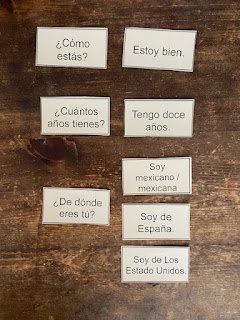Over the years, I have found 6 unconventional ways that I use flash cards to teach Spanish.
1. Portable Word Wall or Spelling Dictionary: Somewhat related to vocabulary memorization, I often have students write reference words or phrases on index cards (you can punch a hole in the corner and put them on a ring).
Great ideas are words that students typically want to use when writing or speaking, or even more "interesting" or "juicy" words that they would like to use more often. For example, lists of words in these "Instead of..." bookmarks are good candidates for portable word walls as well!
2. Pairs of Words or Ideas that Go Together: Students can play "matching" or "memory" games with vocabulary or idea pairs with index cards.
For example, every year, I pull out the notecards when a student needs to memorize Spanish speaking countries and their capitals. Other ideas to pair words could be a word with its synonyms (or antonyms).
Also, don't be afraid to use photos or pictures to pair up famous Hispanics and their accomplishments or just a photo of a person or object and it's characteristics.
3. Mixed up Sentences, Paragraphs, Comics: I often put one or a few words on a notecard that can create a sentence. Students (both beginner and advanced!) love unscrambling sentences. Often a simple preposition will be able to give a clue if the word order is correct or not.
Another idea would be to write one sentence per index card and have the student create a coherent paragraph.
I have also cut up comics (wordless or with words) or just pasted one photo/picture per card and had students put them in order to create a story (sometimes silly, sometimes serious!)
4. Ordering Words or Events: When students need to memorize vocabulary that typically goes in a certain order (such as numbers, days of the week, months of the year...) index cards can be used to put them in the correct order.
Students can also order events using notecards (similar to the game Timeline). This is useful for things that happen during the day (breakfast, lunch, dinner) or even learning about important cultural events, festivals, and holidays.
5. Discussion Prompts and Sentence Starters: Index cards are a terrific tool for teachers and tutors to pull out different discussion prompts for students. You can also mix it up and pull out a discussion prompt and a vocabulary word or two that students need to incorporate into the dialogue. For more beginning students, you can even make "sentence starters" where students can complete a simple thought in Spanish.
6. Conjugating Verbs: Finally, I use flashcards to help students conjugate verbs. Check out this post to see the details on this technique. You can also use the subject and verb as a sentence starter (adding in a prompt such as "Where?" or "How?" or "Why?" or extra vocabulary words for students to add more detail to their response.
What other ways do you use index cards with your students? Please share below!






